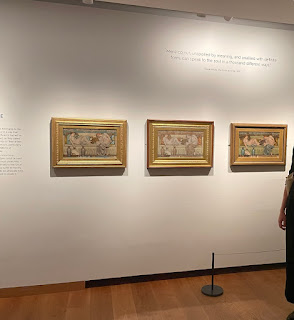Albert Moore: Patterns and Repetitions
The artist Albert Joseph Moore (1851-1893) was best-known for his pictures of women in colourful fabrics, lounging in resplendent interiors with flowers, pillows, sofas, and coloured objects. Often, the women in his paintings appear to repeat each other. Poses reappear throughout, most famously in three works made in 1875: Apples, Beads, and A Sofa.
Moore, Apples, 1875, oil on canvas, 29.2 x 50.7 cm, private collection
Moore, Beads, 1875, oil on canvas, 28.9 x 50.1 cm, National Gallery of Scotland, Edinburgh
Moore, A Sofa, 1875, oil on canvas, 28.9 x 50.1 cm, private collection
These three works, completely identical in composition, only differ in that crucial aspect of being a visual artist: colour. They appear similar to earlier sets, such as Battledore (1868-70, Minneapolis Institute of Art) and Shuttlecock (c. 1870), or Seagulls (1871, Williamson Art Gallery & Museum, Birkenhead) and Shells (1871, Walker Art Gallery, Liverpool).


Left: Battledore, 1868-70, oil on canvas, 106.6 x 44.4 cm, Minneapolis Institute of Art; right: Shuttlecock, c. 1870, private collection.
Moore's interest in these repetitions was mainly a formal one: it was an exploration of hanging drapery, the flow and fall of fabrics, the anatomical positioning of the female body, the compositional balance of decoration, accessories, and body. For example, in Battledore and Shuttlecock, Moore was exploring the dual representation of a set of images, particularly focusing on the movement of drapery. He made many studies, and even had his models run the length of his studio. When the artist Thomas Armstrong and the ceramicist William De Morgan visited Moore in 1869, they witnessed Moore "painting young ladies dressed in white and lilac nocturnes, and I think playing battledore and shuttlecock".
Yet there are still noticeable differences between Battledore and Shuttlecock. In the former, a woman turns to the left, the shuttlecock on her shoulder as the racket leans downwards. Dressed in greens and blues, she stands on a slip of striped matting in a blue interior decorated with swathes of decorated fabric. In Shuttlecock, however, the model is dressed in purples and pinks, in a similar interior but in a different palette, her motions lifting the shuttlecock above the racket. The two works are similar, but not identical.
This would change in 1875, when Moore executed three works that are identical in composition and formal modelling, yet differ in colour. Moore repeats the same scene in different colour schemes. Beads exhibits a colour scheme of predominantly browns with notes of a cool blue - in Apples, only so differentiated by the singular apple on the floor, the browns are replaced with greens, which act as the dominant hues offset by notes of brown. In A Sofa, on the other hand, the juxtaposed colours lie closer together: a dominant brown balanced by other shades of brown and a dark orange. The interesting effect of considering these works next to each other - as the Ashmolean Museum's recent exhibition, Colour Revolution: Victorian Art, Fashion & Design has managed to do - is a striking exercise in exploring differences of the palette. It is clear that Moore was exploring which colour scheme to employ for which effects, inspired by contemporary colour theory by Hermann Helmholtz, Johann Wolfgang von Goethe, and Charles Blanc.





Comments
Post a Comment